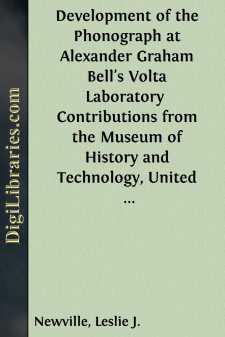Categories
- Antiques & Collectibles 13
- Architecture 36
- Art 48
- Bibles 22
- Biography & Autobiography 813
- Body, Mind & Spirit 142
- Business & Economics 28
- Children's Books 15
- Children's Fiction 12
- Computers 4
- Cooking 94
- Crafts & Hobbies 4
- Drama 346
- Education 46
- Family & Relationships 57
- Fiction 11828
- Games 19
- Gardening 17
- Health & Fitness 34
- History 1377
- House & Home 1
- Humor 147
- Juvenile Fiction 1873
- Juvenile Nonfiction 202
- Language Arts & Disciplines 88
- Law 16
- Literary Collections 686
- Literary Criticism 179
- Mathematics 13
- Medical 41
- Music 40
- Nature 179
- Non-Classifiable 1768
- Performing Arts 7
- Periodicals 1453
- Philosophy 64
- Photography 2
- Poetry 896
- Political Science 203
- Psychology 42
- Reference 154
- Religion 513
- Science 126
- Self-Help 84
- Social Science 81
- Sports & Recreation 34
- Study Aids 3
- Technology & Engineering 59
- Transportation 23
- Travel 463
- True Crime 29
Development of the Phonograph at Alexander Graham Bell's Volta Laboratory Contributions from the Museum of History and Technology, United States National Museum Bulletin 218, Paper 5, (pages 69-79)
Categories:
Description:
Excerpt
The story of Alexander Graham Bell's invention of the telephone has been told and retold. How he became involved in the difficult task of making practical phonograph records, and succeeded (in association with Charles Sumner Tainter and Chichester Bell), is not so well known.
But material collected through the years by the U. S. National Museum of the Smithsonian Institution now makes clear how Bell and two associates took Edison's tinfoil machine and made it reproduce sound from wax instead of tinfoil. They began their work in Washington, D. C., in 1879, and continued until granted basic patents in 1886 for recording in wax.
Preserved at the Smithsonian are some 20 pieces of experimental apparatus, including a number of complete machines. Their first experimental machine was sealed in a box and deposited in the Smithsonian archives in 1881. The others were delivered by Alexander Graham Bell to the National Museum in two lots in 1915 and 1922. Bell was an old man by this time, busy with his aeronautical experiments in Nova Scotia.
It was not until 1947, however, that the Museum received the key to the experimental "Graphophones," as they were called to differentiate them from the Edison machine. In that year Mrs. Laura F. Tainter donated to the Museum 10 bound notebooks, along with Tainter's unpublished autobiography.
This material describes in detail the strange machines and even stranger experiments which led in 1886 to a greatly improved phonograph.Thomas A. Edison had invented the phonograph in 1877. But the fame bestowed on Edison for this startling invention (sometimes called his most original) was not due to its efficiency. Recording with the tinfoil phonograph is too difficult to be practical. The tinfoil tears easily, and even when the stylus is properly adjusted, the reproduction is distorted and squeaky, and good for only a few playbacks. Nevertheless young Edison, the "wizard" as he was called, had hit upon a secret of which men had dreamed for centuries. Immediately after this discovery, however, he did not improve it, allegedly because of an agreement to spend the next five years developing the New York City electric light and power system.
Figure 1.—Charles Sumner Tainter (1854-1940) from a photograph taken in San Diego, California, 1919. (Smithsonian photo 42729-A.)
Meanwhile Bell, always a scientist and experimenter at heart, after his invention of the telephone in 1876 was looking for new worlds to conquer. If we accept Tainter's version of the story, it was through Gardiner Green Hubbard that Bell took up the phonograph challenge. Bell had married Hubbard's daughter Mabel in 1879. Hubbard was then president of the Edison Speaking Phonograph Co., and his organization, which had purchased the Edison patent, was having trouble with its finances because people did not like to buy a machine which seldom worked well and proved difficult for an unskilled person to operate.
In 1879 Hubbard got Bell interested in improving the machine, and it was agreed that a laboratory should be set up in Washington. Experiments were also to be conducted on the transmission of sound by light, and this resulted in the selenium-cell Photophone, patented in 1881. Both the Hubbards and the Bells decided to move to the Capital....


